
The Uniting Church, Benalla
(Photograph by Trevor Bunning (January 2008)]

The Uniting Church, Benalla
(Photograph by Trevor Bunning (January 2008)]
Historical and Technical Documentation by David Shield and Geoffrey Cox
© OHTA 2017 (last updated October 2017)
The Methodist Church was established in Benalla in 1875. The foundation stone for the present church, designed by the architect Alex Eggleston of Melbourne, was laid on 26 March 1930.1 The church was opened and dedicated on 21 September 1930, by which time the pipe organ had been installed. The opening ceremony was conducted by Rev. W.C. Bridgeborn.2
The organ had been built by J.E. Dodd of Adelaide in 1898 for the Primitive Methodist Church, Wellington Square, North Adelaide.3 The North Adelaide Church was opened in June 1882, and closed in June 1929. The building subsequently became the television studio 'Studio 9'.4
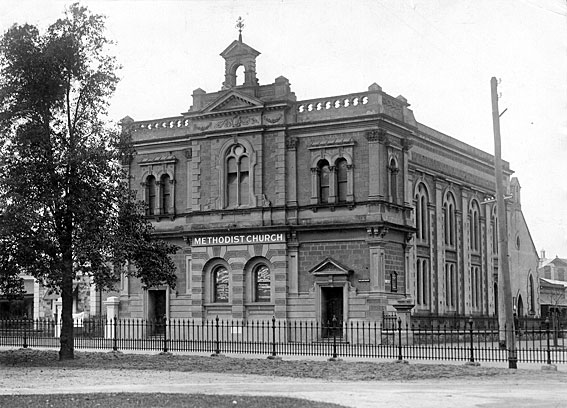
The Primitive Methodist Church, North Adelaide, in 1928
[Photograph: State Library of South Australia (B-4925)]

The J.E. Dodd organ in the Primitive Methodist Church, North Adelaide
[Photograph: Gordon Walker (undated)]
The organ was opened in North Adelaide on Thursday 13 October 1898, with a recital by W.R. Pybus, the Adelaide City Organist:
WELLINGTON-SQUARE CHURCH ORGAN.
The opening of the new pipe-organ at the Wellington - square Primitive Methodist Church attracted a large audience on Thursday evening, when a recital and concert was given to commemorate the event. The Lieutenant-Governor, Right Hon. S. J. Way, presided, and in the course of an appropriate and interesting address referred to the great advances which music was making in our modern Church services. In Scotland an opposition to the 'kist o' whistles' had been vigorously manifested even down to the present day: nevertheless the king of instruments was gradually, even in that country, overcoming all opposition. An organ was unquestionably superior to the band of miscellaneous instruments which used to do duty in the village Church of the old country. He was unfortunately not able to distinguish himself vocally, but he greatly enjoyed good hearty singing, and he thought that in no denomination was such hearty congregational singing found as in the Methodists. He congratulated the Wellington-square Church on the possession of so fine an instrument. After the Chairman's address Mr. T. C. Curtinson, presented Miss Gilmore with a golden key, with which she unlocked the console, and in a short speech declared the organ opened. The audience then joined in another verse of the opening hymn, 'All people that on earth do dwell' and Mr. W. R. Pybus began his programme. This comprised the following items:— 'Offertoire in D' (Batiste), 'Andante in B flat' (Dr. Bridge), 'Sonata' (Otto Diebel), variations on 'As pants the hart' (Spinney), 'Toccata and fugue in D minor' (Bach), selection from Meyerbeer's 'Huguenots,' Raff's 'Cavatina in D,' and Schubert's 'March heroique.' Miss Madeline Wall sang 'Angels ever bright and fair,' from Handel's 'Theodora.' and Mr. Oscar Taeuber was heard in 'Nazareth' (Gounod) and 'The Holy Shrine' (Newton). Special interest attaches to this organ, as it is the first specimen of the king of instruments to be erected in a Primitive Methodist Church in the colony. Although of modest dimensions, the new instrument is complete in every respect; all the stops are of large scale, and the organ is fully equal to every requirement of the Church. The complete specification is as follows: Great. Open diapason, 8 ft. Claribel, 8 ft. Dulciana, 8ft. Principal, 4 ft. Flute, 4 ft. Fifteenth, 2 ft. Swell. Open diapason, 8 ft. Viol d'orchestra, 8 ft. Celeste, 8 ft. Gedacht, 8 ft. Principal, 4 ft. Oboe, 8 ft. Pedal. Sub bass, 16 ft. Prepared for Lieblich Bourdon. Couplers and Accessories. Three couplers. Three compositions to great. Balanced swell pedal. With the exception of the metal pipes, which are from a London firm of high repute, the whole of the organ was manufactured by Mr. J. E. Dodd at his factory in Twin-street, Adelaide. The action is entirely tracker, and the touch admirably light and responsive. For its size, the instrument is very effective, and of all the stops the one calling for special note is the great open diapason, which is singularly rich and powerful, and strikes us as one of the best of its class that we have heard. The flute, gedacht, and claribel, all wooden stops of colonial manufacture, are of excellent quality, the individual characteristics of each being amply displayed, while their tone is beautifully clear and even. The swell oboe is a good reed, full and at the same time free from any suspicion of harshness, and the balance of tone of both manuals, as well as the full organ, is all that could be desired. The instrument is enclosed in an attractive case, stained and varnished to imitate two shades of walnut, and presents a handsome appearance. Mr. E. F. Troy has decorated the pipe front— which consists of two towers and three flats formed of the largest metal pipes— in an artistic manner, that harmonises capitally with the scheme of colour adopted in the decoration of the Church. Of its size, the organ may be pronounced one of the best in the colony.5
Following the closure of the North Adelaide church in 1929, the organ found its way to Benalla in time for the opening of the new church in 1930.
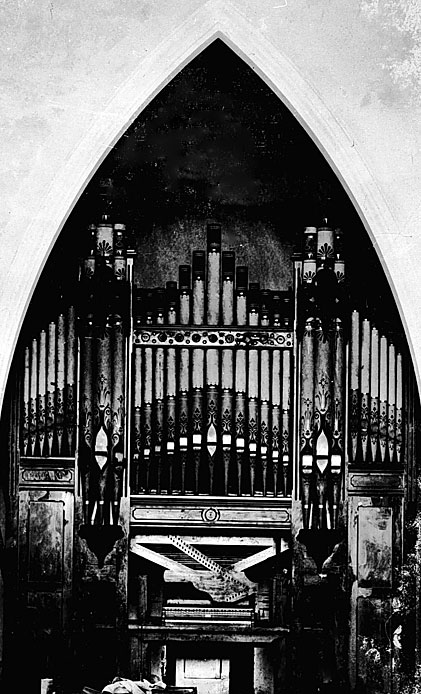
The Dodd organ, apparently being installed at Benalla
[Photograph dated c.1925(?) by Benjamin Graham
- Museums Victoria, Item MM 8055
(incorrectly catalogued as "Pipe Organ in a Church, Werribee, Victoria")]

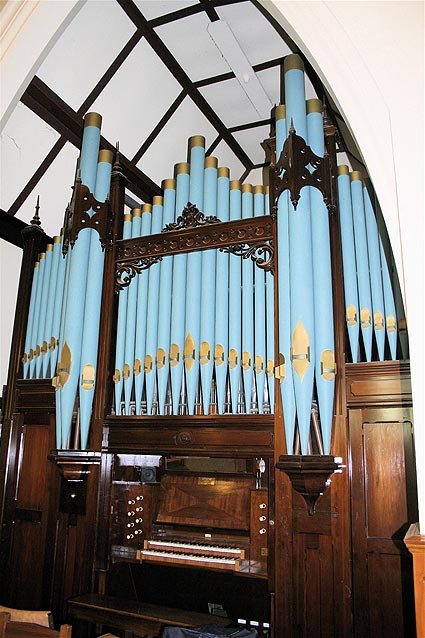
[Photographs by Trevor Bunning (January 2008)]
The organ was rebuilt in 1975 by Geo Fincham & Sons, with new mechanical action. There were no essential changes to the specification, although the stop nomenclature was slightly altered, and new keyboards, pedalboard and drawstops were provided.
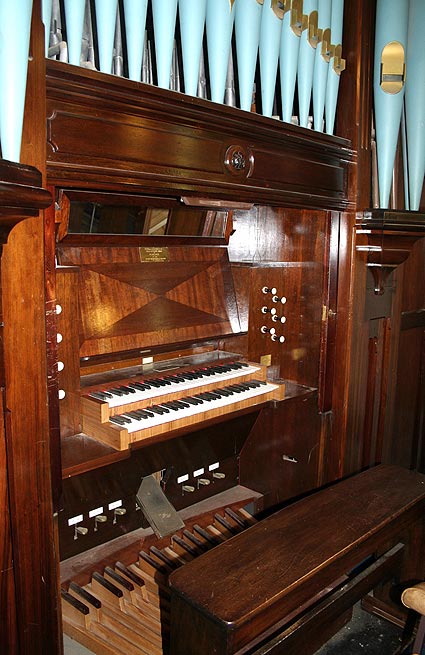
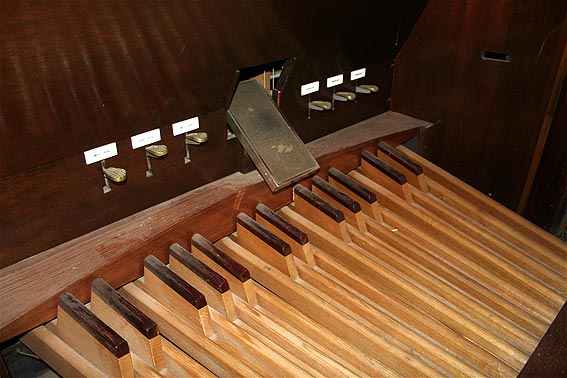
Console details of the rebuilt organ
[Photographs by Trevor Bunning (January 2008)]
The current specification, which uses slightly altered stop nomenclature, is as follows:
| GREAT Open Diapason Dulciana Claribel Principal Wald Flute Fifteenth SWELL Open Diapason Lieblich Gedackt Viole d'Orchestre Voix Celeste Principal Oboe Tremulant PEDAL Bourdon COUPLERS Swell to Great Swell to Pedal Great to Pedal |
8 8 8 4 4 2 8 8 8 8 4 8 16 |
3 combination pedals levers
The key and stop action is mechanical.6

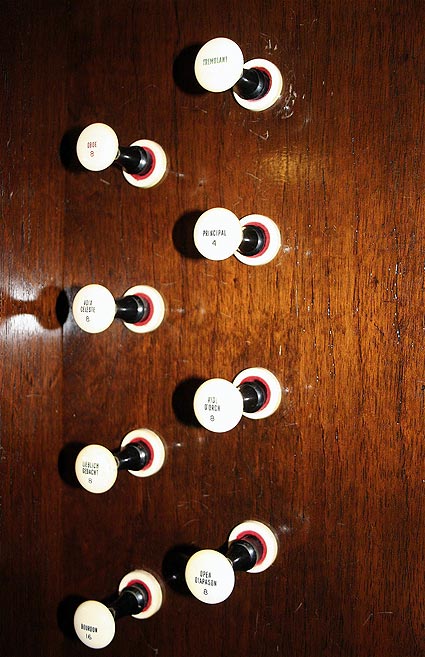
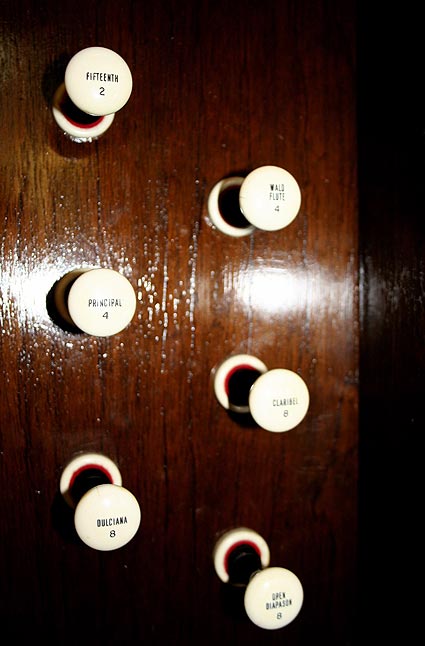
Stops jambs of the rebuilt organ
[Photographs by Trevor Bunning (January 2008)]
1 http://vhd.heritagecouncil.vic.gov.au/places/196628/download-report - accessed September 2017.
2 The North Eastern Ensign (26 September 1930), p. 3; The Age (6 October 1930), p. 13.
3 List of organs built by J.E. Dodd, Adelaide (copy held by OHTA, South Australia).
4 The South Australian Advertiser (27 June 1882), p. 5; South Australian Weekly Chronicle (1 July 1882), p. 7; The Advertiser (14 July 1929), p. 11; SA Heritage Register – State Heritage ID 13497.
5 The Register (14 October 1898), p. 3. See also: Express & Telegraph (14 October 1898), p. 3, Music (Jan 1899), and The South Australian Advertiser (14 October 1898), p. 6.
6 Specification noted by Trevor Bunning, 15 January 2008.
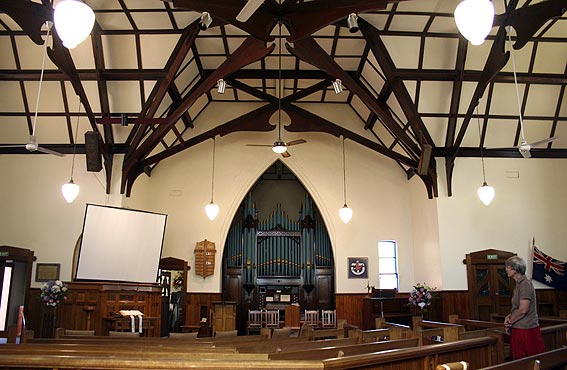
[Photograph by Trevor Bunning (January 2008)]